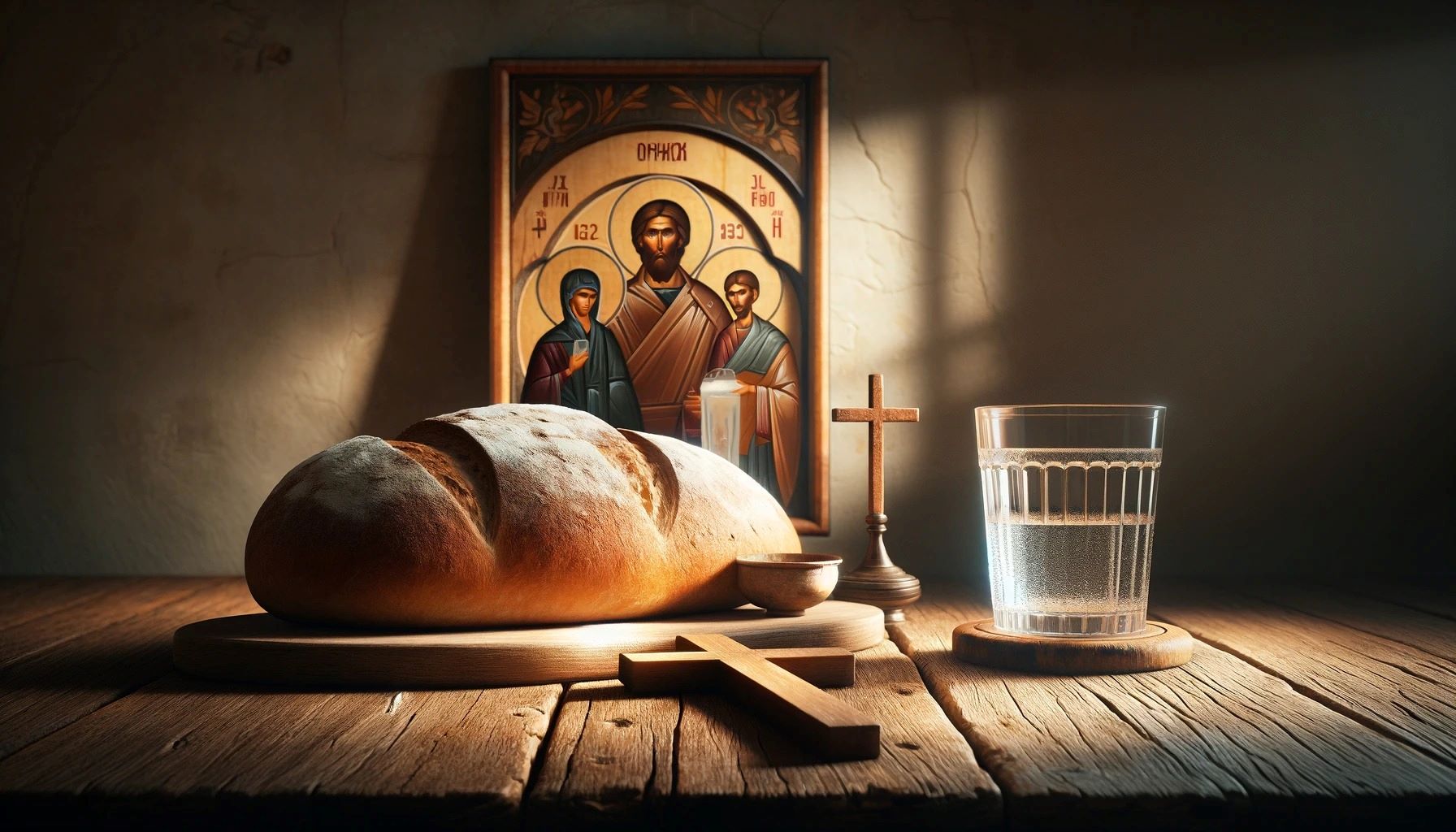Home>Special Themes>Why Did Fish Become Okay To Eat During Lent


Special Themes
Why Did Fish Become Okay To Eat During Lent
Published: February 28, 2024
Ericka Andersen, an editor at Christian.net, expertly merges digital strategy with content creation, focusing on faith and societal issues. Her communication skills enhance the platform's engaging narratives, fostering meaningful dialogue on belief's impact on society.
Discover the history behind why fish became an acceptable food during Lent and explore the significance of special themes in religious dietary practices. Uncover the cultural and religious reasons for this dietary tradition.
(Many of the links in this article redirect to a specific reviewed product. Your purchase of these products through affiliate links helps to generate commission for Christian.net, at no extra cost. Learn more)
Table of Contents
The History of Lent and Dietary Restrictions
Lent, a period of 40 days leading up to Easter, has been observed by Christians for centuries as a time of fasting, repentance, and spiritual discipline. The practice of fasting during Lent has its roots in the early Christian church, where believers would abstain from certain foods as a way to commemorate the 40 days that Jesus spent fasting in the wilderness. Over time, the specific dietary restrictions associated with Lent have evolved, but the underlying purpose of self-denial and spiritual reflection has remained constant.
-
Early Christian Practices: In the early centuries of the church, Lenten fasting was a strict and rigorous practice, with believers abstaining from all animal products, including meat, dairy, and eggs, for the entire duration of Lent. This period of fasting was seen as a way to imitate Jesus' sacrifice and to prepare for the celebration of his resurrection at Easter.
-
Development of Dietary Guidelines: As the church grew and spread to different regions, variations in Lenten fasting practices emerged. In some areas, the consumption of fish was allowed, while in others, it was considered a violation of the Lenten fast. These differences were often influenced by local customs, cultural traditions, and the availability of certain foods.
-
The Role of Church Authority: Over time, the church began to formalize its guidelines for Lenten fasting, with bishops and religious leaders issuing decrees about which foods were permissible during this period of penitence. The consumption of fish emerged as a common compromise, as it was seen as a food of simplicity and humility, in keeping with the spirit of Lent.
-
Reformation and Modern Practices: The Protestant Reformation brought further changes to the observance of Lent, with some branches of Christianity abandoning the practice of fasting altogether, while others retained modified forms of dietary restrictions. Today, the specific rules regarding Lenten fasting vary among different Christian denominations, with some allowing the consumption of fish and other animal products on certain days, while others maintain more traditional guidelines.
The history of Lent and its dietary restrictions reflects the complex interplay of religious, cultural, and historical factors that have shaped the practices of the Christian faith. The evolution of attitudes toward food and fasting during Lent has been influenced by a wide range of considerations, from theological interpretations to practical concerns about nutrition and sustenance. Understanding this history provides insight into the significance of dietary choices during this sacred season.
The Role of Fish in Religious Symbolism
-
Biblical Symbolism: In the Christian tradition, fish hold a significant symbolic meaning, rooted in the New Testament accounts of Jesus' ministry. The miraculous multiplication of loaves and fishes, the calling of the disciples as "fishers of men," and the post-resurrection appearance of Jesus sharing a meal of fish with his followers all contribute to the rich symbolism of fish in Christianity.
-
Early Christian Iconography: The image of the fish, known as the ichthys, became an important symbol of faith and identity for early Christians. In a time of persecution, the fish served as a covert sign of Christian belief, as its Greek letters formed an acronym for "Jesus Christ, Son of God, Savior."
-
Spiritual Significance: Beyond its historical and cultural associations, the fish came to represent spiritual themes such as abundance, sustenance, and the nourishment of the soul. As a food that was readily available to many people, fish also embodied the virtues of simplicity and humility, qualities that were highly valued in the context of Lenten observance.
-
Eucharistic Symbolism: In the sacramental life of the church, the fish took on additional layers of meaning. As a staple food in many communities, fish became associated with the act of sharing meals and the communal aspect of Christian fellowship. This communal dimension resonated with the Eucharistic symbolism of sharing in the body and blood of Christ.
-
Cultural Adaptations: The symbolism of fish in Christianity has been further enriched by the diverse cultural contexts in which the faith has spread. In regions where fishing was a central economic activity, the imagery of fish became intertwined with local traditions and folklore, deepening its significance within the religious life of those communities.
-
Continued Relevance: Today, the symbolism of fish remains a potent and multifaceted element of Christian spirituality. During Lent, the consumption of fish serves as a tangible reminder of these symbolic associations, inviting believers to reflect on the spiritual dimensions of their dietary choices and the deeper meanings of sustenance and sacrifice.
Understanding the role of fish in religious symbolism provides insight into the layers of meaning that underlie the practice of consuming fish during Lent. It illuminates the ways in which religious traditions draw on rich and diverse symbols to convey profound truths and to shape the lived experience of faith.
The Influence of Cultural and Geographical Factors
-
Regional Dietary Practices: The observance of Lent and the consumption of fish have been significantly influenced by the diverse dietary customs of different regions. In coastal areas, where fishing was a primary source of sustenance, the inclusion of fish in Lenten meals was a natural and practical adaptation. The abundance of fish in these regions made it a readily available and affordable food option for the period of Lent. In contrast, inland regions with limited access to fish often developed alternative Lenten traditions, such as the consumption of vegetable-based dishes or the exclusion of specific food groups.
-
Cultural Traditions and Symbolism: The cultural significance of fish in various societies has also played a role in shaping the observance of Lent. In many cultures, fish have been associated with themes of abundance, fertility, and spiritual purity. These symbolic meanings have intersected with religious practices, influencing the perception of fish as a fitting food for the Lenten season. Additionally, the culinary traditions and recipes surrounding fish have been passed down through generations, becoming integral to the cultural heritage of many communities.
-
Historical Context and Economic Factors: Historical events and economic conditions have further impacted the role of fish in Lenten observance. Periods of scarcity or economic hardship may have led communities to prioritize the consumption of fish as a practical and affordable source of nutrition during Lent. Similarly, the influence of trade routes and culinary exchanges has contributed to the incorporation of diverse fish varieties and cooking methods into Lenten cuisines, reflecting the interconnectedness of global food cultures.
-
Liturgical and Ritual Practices: The influence of cultural and geographical factors is also evident in the liturgical and ritual practices associated with the consumption of fish during Lent. In some regions, the preparation and sharing of fish-based meals hold deep cultural and communal significance, becoming an integral part of the religious observance. These practices reflect the ways in which local customs and traditions have become intertwined with the religious expression of faith, enriching the experience of Lent for believers across different cultural landscapes.
-
Contemporary Adaptations and Globalization: In the modern era, cultural and geographical influences continue to shape the observance of Lent and the consumption of fish. As societies become increasingly interconnected through globalization, the exchange of culinary practices and the availability of diverse fish species have contributed to the evolution of Lenten dietary traditions. This ongoing interplay of cultural and geographical factors underscores the dynamic nature of religious practices and the ways in which they intersect with the broader tapestry of human experience.
Understanding the influence of cultural and geographical factors provides a nuanced perspective on the diverse expressions of faith and the adaptive nature of religious traditions. It highlights the ways in which local contexts and global dynamics have shaped the observance of Lent, contributing to the rich tapestry of religious and cultural heritage.
The Evolution of Church Doctrine on Lenten Fasting
-
Early Christian Practices: In the early centuries of the church, the observance of Lenten fasting varied widely across different regions and communities. While the general emphasis on self-denial and spiritual discipline was consistent, the specific rules regarding dietary restrictions were not universally standardized. Some communities practiced strict fasting, abstaining from all animal products, while others allowed for greater flexibility in the consumption of certain foods. This diversity reflected the decentralized nature of early Christianity and the absence of uniform doctrinal regulations.
-
Development of Ecclesiastical Guidelines: As the church began to codify its teachings and establish ecclesiastical authority, the question of Lenten fasting became a subject of theological and pastoral concern. Bishops and church leaders sought to provide clarity and consistency in the observance of Lent, issuing decrees and guidelines to regulate the practices of fasting and abstinence. These efforts aimed to align the diverse customs and traditions of fasting with the broader doctrinal framework of the Christian faith, emphasizing the spiritual significance of self-discipline and penitence.
-
The Role of Church Councils: The evolution of church doctrine on Lenten fasting was further shaped by the deliberations of ecumenical councils and synods. These gatherings of bishops and theologians addressed theological controversies and pastoral issues, including the regulation of Lenten practices. Through conciliar decrees and canons, the church articulated specific rules regarding the duration of Lent, the types of foods to be abstained from, and the spiritual purposes of fasting. These doctrinal developments aimed to foster a sense of communal unity and shared discipline among the faithful.
-
Reformation and Post-Reformation Influences: The Protestant Reformation brought significant changes to the observance of Lent and the church's doctrine on fasting. Reformers such as Martin Luther and John Calvin challenged certain traditional practices of fasting, critiquing what they perceived as externalized forms of piety divorced from genuine faith. As a result, some Protestant denominations modified or abandoned the practice of Lenten fasting, while others retained a renewed emphasis on spiritual disciplines. These divergent responses to Lent reflected broader theological and ecclesiological shifts within the Protestant tradition.
-
Contemporary Perspectives and Ecumenical Dialogue: In the present era, the evolution of church doctrine on Lenten fasting continues to be a subject of theological reflection and ecumenical dialogue. Christian communities engage in conversations about the relevance of traditional fasting practices, the pastoral needs of believers, and the cultural contexts in which Lent is observed. The ecumenical movement has fostered greater collaboration and understanding among different Christian traditions, leading to shared statements and common initiatives related to Lenten observance.
-
Theological Reflection and Spiritual Renewal: The evolution of church doctrine on Lenten fasting reflects a dynamic process of theological reflection and spiritual renewal within the Christian tradition. As the church grapples with the changing realities of contemporary life, it seeks to uphold the enduring values of self-discipline, repentance, and solidarity with the marginalized. The ongoing evolution of Lenten fasting doctrine underscores the living nature of Christian faith, as it engages with the complexities of history, culture, and human experience.
Understanding the evolution of church doctrine on Lenten fasting provides insight into the ways in which the Christian tradition has grappled with questions of spiritual discipline, communal identity, and doctrinal authority. It illuminates the dynamic interplay of theological reflection, pastoral adaptation, and historical contingencies that have shaped the observance of Lent within the broader tapestry of Christian spirituality.
The Nutritional Benefits of Eating Fish During Lent
-
Rich Source of Protein: Fish is a valuable source of high-quality protein, essential for the growth and repair of body tissues. During Lent, when meat consumption is restricted, fish provides an important alternative protein source that supports overall health and well-being.
-
Omega-3 Fatty Acids: Many varieties of fish are rich in omega-3 fatty acids, which are known for their heart-healthy benefits. These essential fats contribute to cardiovascular health, reducing the risk of heart disease and supporting optimal brain function.
-
Vitamins and Minerals: Fish is a nutrient-dense food, containing essential vitamins and minerals such as vitamin D, vitamin B12, iodine, and selenium. These nutrients play crucial roles in maintaining bone health, supporting immune function, and promoting overall vitality.
-
Low in Saturated Fat: Compared to many types of meat, fish is generally low in saturated fat, making it a heart-friendly dietary choice. By incorporating fish into their Lenten meals, individuals can reduce their intake of saturated fats and cholesterol, contributing to better cardiovascular health.
-
Versatility in Cooking: The diverse range of fish species offers a wealth of culinary possibilities, allowing for creative and nutritious meal options during Lent. From grilled salmon to baked cod to fish stews, the versatility of fish makes it a valuable addition to a balanced and varied diet.
-
Sustainable and Eco-Friendly: As concerns about environmental sustainability grow, the consumption of fish during Lent aligns with principles of eco-conscious eating. Choosing sustainably sourced fish supports responsible fishing practices and the preservation of marine ecosystems.
-
Cultural and Culinary Traditions: Many cultures have developed rich culinary traditions centered around fish, incorporating a variety of flavors, spices, and cooking techniques. Embracing these traditions during Lent not only provides nutritional benefits but also fosters a deeper appreciation for diverse cultural heritages.
-
Promotion of Dietary Diversity: Including fish in the Lenten diet promotes dietary diversity and encourages individuals to explore alternative sources of nourishment. This diversification of food choices contributes to a well-rounded and balanced approach to nutrition.
-
Symbolism of Abstinence and Simplicity: Beyond its nutritional value, the consumption of fish during Lent carries symbolic significance, reflecting themes of abstinence, simplicity, and humility. This symbolic dimension enriches the experience of Lenten fasting, inviting believers to reflect on the spiritual dimensions of their dietary choices.
-
Health Benefits for All Ages: The nutritional benefits of fish extend to individuals of all ages, from children to the elderly. By incorporating fish into Lenten meals, families and communities can promote health and well-being across generations, fostering a culture of holistic nourishment.
Understanding the nutritional benefits of eating fish during Lent underscores the multifaceted significance of dietary choices within the context of religious observance. It highlights the ways in which food can serve as a source of physical nourishment, cultural expression, and spiritual reflection, enriching the experience of the Lenten season.















